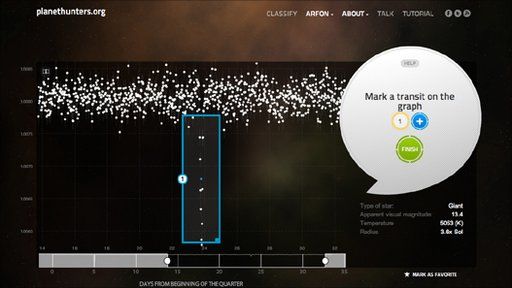Amateur stargazers spot two new exoplanets
- Published
- comments

Have you spotted the tell-tale signature of an earth-like world orbiting a distant star?If you're one of the Today programme listeners who signed up to help analyse the images being generated by Nasa's Kepler Space Observatory last year, then your name could appear as a co-author on a scientific paper detailing the discovery of two new planets.
Back in December we asked listeners to help scientists wade through the colossal amount of data being produced by Kepler, which has been sitting out in deep space quietly photographing a patch of sky between the constellations Cygnus and Lyra every 30 seconds or so for the past two years.
While the computer algorithms astronomers use to process these images are good at spotting huge Jupiter-like gas giants, they're much less reliable when it comes to identifying the subtle dip in stellar luminosity as a smaller planet transits in front of its parent star.
For that Nasa needed the pattern processing powers of a much more sophisticated computer - the human brain.
The result was Planethunters.org - a website set up by physicists at the University of Oxford allowing anyone with a keen eye and a little time on their hands to sift through the Kepler data on thousands of individual stars and submit likely candidates for hidden planets.
Over 45,000 amateur enthusiasts responded, and after careful analysis and follow-up observations using the Keck telescope in Hawaii, the Planet Hunters team at Oxford submitted ten potential planets from the first tranche of Kepler data for verification by Nasa. Two of those have now been found to meet the space agency's stringent criteria and have been officially confirmed as candidate planets.
"These are planets that had slipped through our fingers" says Oxford University's Dr Chris Lintott, "they had escaped our automatic detection methods, and they've been rescued by the heroic efforts of the people who visited our website."
One of the new planets is just two and a half times the size of the earth and has a solid surface making it a possible home for extraterrestrial life. The second is a gas giant more like Jupiter and orbits its parent star every 50 days.
A paper detailing the discoveries "Planet Hunters: Two Planet Candidates Discovered by the Public using the Kepler Public Archive Data" has been submitted to the journal Monthly Notices of the Royal Astronomical Society and will be published shortly.
The list of authors will include the name of the amateur astronomer who first spotted it - worth checking if you're one of the Today programme listeners who took up the challenge to search through the Kepler data back in December.